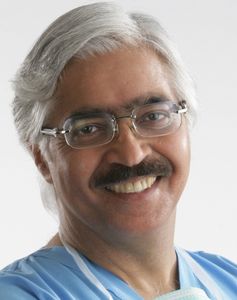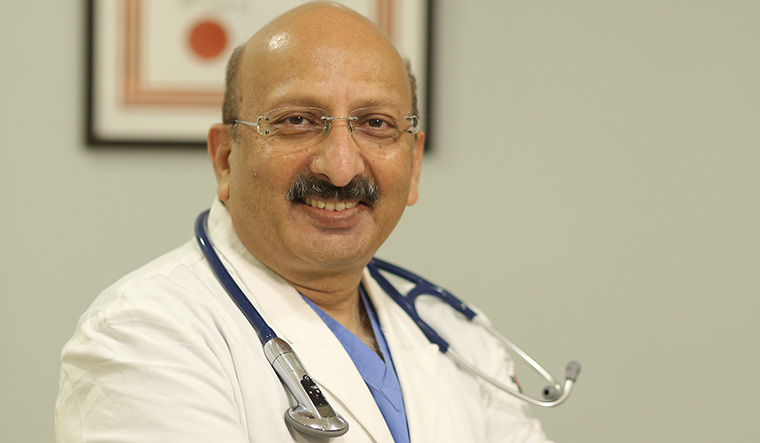In the past, many disorders of the heart could be treated only by surgery. Now, interventional cardiology has revolutionised cardiac care. “It is a nonsurgical way to treat heart diseases, that too under local anaesthesia,” says Dr Ashok Seth, chairman of Fortis Escorts Heart Institute, Delhi, and a Padma Bhushan recipient. “These procedures are safer and less traumatic. The patient gets discharged from the hospital within 48 hours. It gives similar and safer results as bypass surgery in many patients.”
Interventional cardiology also holds much promise when medications fail or when surgery is not possible. THE WEEK spoke to two leading interventional cardiologists to know more about the subject. Excerpts from the interviews:
Interview/ Dr Ashok Seth, Chairman, Fortis Escorts Heart Institute, Delhi
Q Who is a good candidate for an interventional cardiology procedure like angioplasty?
A For patients who have had a heart attack or those with rapidly worsening angina, nonsurgical treatment is safe and effective. We put in small pumps, called Impella pumps, in the heart, keeping the heart supported in a safe manner while doing angioplasty under local anaesthesia and then take the pump out after a very complicated procedure.
Holes in the heart used to be treated with surgery. You had to open the chest, put a patch on that hole and treat it. Now it can be done using interventional cardiology techniques mostly under local anaesthesia. Patches can be inserted into the heart using catheters and the holes can be closed. Similarly, a main valve in the heart can be changed without an open-heart surgery.
It is useful especially for the elderly. For younger patients, surgery is recommended.
Then there are those who had bypass surgery or valve replacement in the past and therefore cannot easily have repeat operations of the chest. People who are above 75 sometimes develop valve diseases. They may die within six months to a year if they are not treated. As many as 50 per cent of elderly patients who develop valve diseases cannot actually have surgery because of [several] factors. They can be safely treated with interventional cardiology procedures.
Also, science is ensuring we do not leave any metal inside our arteries like the medicated stents. We are looking at dissolvable stents... called bioresorbable scaffolds. I introduced the first such stent in Asia in 2010. This is an arena of great research and development.
As interventional cardiologists, we do minimally invasive procedures in conscious patients.... The valve can be replaced in an hour’s time. The patient can walk around in eight to 10 hours.
Nonetheless, individuals with multiple blockages, all the three arteries blocked, main artery blocked, or diabetics with multiple blockages, are better treated by bypass surgery.
Q How did interventional cardiology come into being?
A In the late 1970s and early 1980s, we found ways to open up blockages in arteries without surgery. That is how interventional cardiology came into being.
Q Are these procedures affordable for the common man?
A In multiple instances, it is cheaper than surgery. It becomes as expensive or even more expensive than surgery when we have to put multiple stents or treat complicated blockages.
Q What are the most significant advances in interventional cardiology?
A Medicated stents have been a real game-changer. Angioplasty with medicated stents is a life-saving treatment for heart attacks as well as severe blockages.
Q You demonstrated the Impella pump to the US medical community through live transmissions from India.
A Yes. In 2007, we were the first ones to use the Impella pump in Asia Pacific, and to demonstrate it in the biggest [medical] meeting in the world in the US. After the FDA approval, it became less available to us because of the demand in the US. We reintroduced it in the country in 2018.
Now it is being widely used, even though it is expensive in our country. We wish advancements in science and technology would become available to the common man in this country
-------------------------------------------------------------------------------------------------------------------------------
Interview/ Dr Praveen Chandra, Chairman of interventional cardiology at Medanta-The Medicity, Gurugram
Q Interventional cardiology has made giant strides in recent times. What are the new treatment options available for people with blockages in the heart?
A For simple blockages we just do ballooning and stenting. For complicated blockages, sometimes we do a stent-less angioplasty. We do therapies to open the blockages.
Q What is new in valve replacement?
A Patients who cannot undergo surgery because of advanced age or other risk factors can now opt for interventional cardiology techniques like TAVI (transcatheter aortic valve implantation). TAVI allows us to replace the heart valve without surgery. During TAVI, the patient will be conscious. There is no general anaesthesia. No cut, no stitch. We put the catheter from the groin and do the procedure. Patients feel very well after it.
Also read
- Medical landscape in India is changing post Covid
- How cancer screening and detection has changed since Covid-19
- How Apollo Cancer Centres are predicting and detecting cancers early
- Exclusive: AIIMS director Dr M. Srinivas on what makes it topper
- How India’s first shoulder-level hand transplant was done
- The art of performing complex surgeries
If the heart valve starts leaking, it causes a lot of breathlessness and the patient is not able to walk well. Some develop sleep problems as well. When these patients are referred for surgery, we find that they cannot undergo surgery. MitraClip (procedure to fix mitral valve) is useful for patients [with a damaged mitral valve]. The patient has to be admitted just for a day. Again, no cut or stitch.
Q How does laser angioplasty help treat recurrent blockages?
A Laser is a good option for post-bypass patients who develop blockages again. We have techniques to check the blockages by advanced imaging methods. Intravascular ultrasound is a miniature ultrasound that can go deep inside the heart. Ultrasound is done by a small machine and the patient has to lie down and then, from the top of the body, you can do the scan. Intravascular ultrasound goes inside the heart. It takes very fine images of the heart, which helps us understand where exactly the problem is and how serious it is. We can also check the results of stenting and see whether there is any residual problem. All these can be done more accurately and precisely using intravascular ultrasound. It gives more predictable outcomes.



